![]()
![]()
![]()
Use LEFT and RIGHT arrow keys to navigate between flashcards;
Use UP and DOWN arrow keys to flip the card;
H to show hint;
A reads text to speech;
43 Cards in this Set
- Front
- Back
|
Neurons have 4 zones for information processing: |
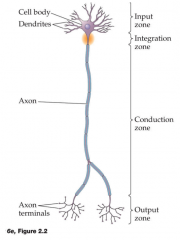
1. Input zone: Dendrites receive signals from neighboring neurons The Nervous System How the Nervous System Works 2. Integration zone: Cell body (soma) contains the nucleus where inputs are combined and integrated 3. Conduction zone: Axon extends away from the cell body transmitting the signal integrated at the soma 4. Output zone: Axon terminals (synaptic bottons) are the neurons output zone. They allow signals to be released from one neuron in order to reach another |
|
|
The Synapse: x3 components |
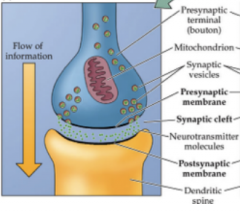
Presynaptic Membrane, Postsynaptic Membrane, and Synaptic Cleft Neurons communicate at synapses Stimulation of the neuron results in release of neurotransmitters from the presynaptic neuron Neurotransmitters can be: Excitatory: GlutamateInhibitory: GABA |
|
|
Myelin Glial cells ? process? how long? node of ranvier ? |
Glial cells are wrapped along the length of many axons forming Myelin The process of forming Myelin is called Myelination and may not be complete until 10-15 years after birth The gap between two segments of myelin sheathing is a node of ranvier 2 functions of myelin: 1. protect axons 2. increases speed of signal transduction along the axon |
|
|
Divisions of the Nervous System Natural subdivision between two general parts of thenervous system: |
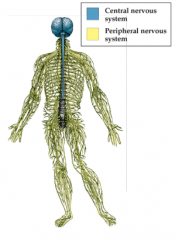
1. Central Nervous System(CNS): Brain and Spinal Cordall contained within thebones of the skull and spinalcolumn 2.Peripheral Nervous System(PNS): All the nerves outsideof the spinal column |
|
|
Divisions of the PeripheralNervous System (2) |
1. Somatic Nervous System:Part of the nervous system that interacts with the external environment. 2. Autonomic Nervous System:Part of the PNS that controls the body’s internal environment. A regulatory system that controls the internal organs. |
|
|
Somatic Nervous System Includes (2) types of nerves: +signals |
1. Spinal Nerves Nerves can be... afferent: carry signals to the CNS (sensory)efferent: carry signals away from the CNS (motor) EXIT 2. Cranial Nerves |
|
|
Autonomic Nervous System 2 Divisions of the Autonomic Nervous System: think of automatic functions** |
1. Sympathetic-“fight or flight response” prepares the body for action- nerves generally arise from the thoracic and lumbar regions 2. Parasympathetic-prepares the body for rest and recovery-nerves generally arise from cranial and sacral regions |
|
|
“fight or flight response” x4 biological reactions |
Saliva production:decreased Increases heartrate Inhibits digestion Stimulates hormone release from theadrenal gland -increases release of stress related hormones |
|
|
Autonomic Nervous System3 Important principles |
1. Sympathetic nerves stimulate, organize and mobilize resources in response to threat. Parasympathetic nerves conserve energy (subdiv) 2. Organs receive both opposing sympathetic and parasympathetic activation the response of the organ depends on the level of sympathetic vs parasympathetic input at the time. 3. Sympathetic changes - Psychological Arousal Parasympathetic changes - Psychological Relaxation |
|
|
Diagram, memorize it and draw |
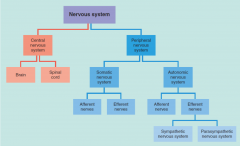
|
|
|
The Central Nervous System - The Forebrain Two main subdivisions |
1. Telencephalon - Cerebrum(lobes) and hippocampus 2. Diencephalon - Thalamus and Hypothalamus Thalamus - relay station between your senses and the rest of your nervous systemHypothalamus - maintains homeostasis, important in stress response, controls, eating,drinking, motivation |
|
|
The Central Nervous System - The Cerebellum |
Helps coordinate our movement and balance Ataxia - movements that are uncoordinated and jerky Symptom of many conditions:strokeMultiple SclerosisAlcohol abusemedications - barbiturates, benzodiazepinesvitamine deficiency (B12)Hereditary ataxias |
|
|
The Central Nervous SystemThe BrainstemFour parts: |
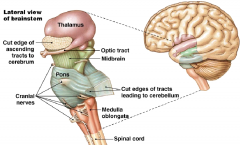
1. Midbrain - top of brainstem, info from auditory and visceral (internal organs)system. 3. Pons - Facial movements, controlling the eyes, swallowing 4. Medulla Oblongata - breathing, heart rate: damage often life threatening 2. Reticular activating system - neurons that span the brainstem -controlling arousal and consciousness (damage coma) |
|
|
The Central Nervous System - The Spinal Cord |
Responsible for messages between the brain and the body Efferent neurons - information away (exit)from the brain Afferent neurons - information toward thebrain Consequences of spinal damage demandon the region (high vs low) and severity(crushed, severed) |
|
|
The Endocrine System |
Both CNS and endocrine systems communicate with the rest of the body CNS - electrical and chemical communication: quick (NT’s) Endocrine - chemical communication: slower (hormones) |
|
|
1. Endocrine and Nervous Systems Working Together |
The CNS and the endocrine system are linked via projections from the hypothalamus to the pituitary (hypophysis) Hormones control critical physiological functions:reproduction, blood pressure, growth, appetite |
|
|
Particularly relevant to this course: The hypothalamic - pituitary - adrenal axis |
https://www.youtube.com/watch?v=DduN12D019M |
|
|
2. Adrenal Glands |
Release hormones Epinephrine and Norepinephrine - work with CNS to alter heart rate, respiration rate Chronic high levels of these types of hormones is associated with health side effects- hypertension- ulcers |
|
|
3. Other Glands x3 |
Thymus gland - important in antibody production in early development Thyroid gland - produces thyroxine=activity level/growth hypothyroidism - insufficient secretion of TSH (thyroid stimulatinghormone) or thyroxine. Low activity, weight gain, cognitive impairment,stunting of growth hyperthyroidism - excess secretion of TSH or thyroxine. High activitylevels, weight loss, insomnia, anxiety, irritability, increased thirst/urination Pancreas - regulates blood sugardiabetes - pancreas doesn't secrete enough insulin to remove sugarfrom the blood |
|
|
The Digestive System 1. Digesting FoodTwo types of digestion |
1. mechanical - chewing, peristalsis 2. Digestion begins in the mouth - chewing and saliva contains enzymes Down esophagus - peristalsis contraction 3. Stomach - gastric juice (acidic HCL) and pepsin (breaks down proteins) *churns*3-4hrs semi liquid mixture 4. peristalsis->Duodenum pancreatic enzymes break down (carbs,proteins and fats), absorption of nutrients increases Small intestine 5. Large intestine and Colon - absorption of water 1st half, feces and elimination |
|
|
2. Disorders of the Digestive System x6 |
Ulcers - sores on the lining of the stomach and small intestine causes: bacterial infection, too much acid. Characterized by abdominal pain Related to Stress Irritable Bowel Syndrome - gastrointestinal disorder of no known cause. Characterized by bloating, abdominal pain, abnormal bowel movements Hepatits - viral diseases leading to liver inflammation hepatitis A - water and food hepatitis B and C - bodily fluids, sexual contact, transfusions, IV drug use Cirrhosis - tissue damage to the liver impairing its function. Related to hepatitisand alcohol abuse Inflammatory Bowel Disease - includes chrones and ulcerative collitis both are autoimmune disorders targeting the digestive system Cancer - any part of the digestive tract |
|
|
How does absorption occur? |
Intestine wall has many folds that contain projections The two projection contains a network of structures thatwill accept the molecules and transport them away to other parts of the body These structures include tiny blood vessels called cappillaries and tube called a lacteal Capillary- absorb amino acids, simple sugars, and water aswell as fatty acids, vitamins and minerals Lacteals accepts glycerol and the remaining fatty acids andvitamins |
|
|
Three principle outcomes of metabolism... |
refers to all chemical reactions that occur in the body's cells synthesis- build and repair body regulation- producing enzymes and hormones energy- heat the body and fuel activities |
|
|
The Respiratory System |
Breathing provides body with oxygen (required for metabolism) and eliminates waste (carbon dioxide) |
|
|
The Respiratory System The Respiratory Tract process x 4 steps what makes the air go in and out?? |
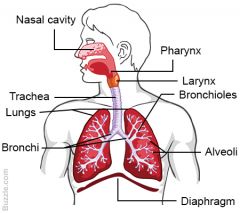
Air in - nose and mouth past larynx down trachea into bronchi (bronchial tubes) into lungs bronchial tubes divide into smallerbronchioles which terminate in tinylittle alveoli (important in gasexchange (oxygen and carbondioxide) Diaphragm is important for maintaining negative pressure required for breathing |
|
|
Respiratory Functions and Disorders Respiration is required for... |
maintaining sufficient levels of oxygen in the blood to be delivered to tissues of the body via the circulatory system 1. reflexes sneezing or coughing 2. mucociliary elevator - mucus and cilia cause us to swallow foreign bodies and digest them |
|
|
x4 respiratory diseases |
pneumonia - bacterial or viral infection - inflammation and fluid
emphysema - destruction of alveoli decreasing gas exchange, which chronic bronchitis (COPD) asthma - narrowing of bronchial airways Cancer - lung, trachea, mouth |
|
|
The Cardiovascular System |
Supplies the body with substances needed for normal function (nutrients,gases, immune factors, hormones etc) Removes wastes of metabolism 1.The Heart and Blood Vessels 2. Blood Pressure 3. Blood Composition 4. Cardiovascular Disorders |
|
|
The heart and blood vessels Heart - definition Arteries definition |
muscle, the muscle wall is called the myocardium 4 chambers: 2 artia (atrium sing) at the top; 2 ventricles at the bottom Arteries - carry blood away from the heartVeins - carry blood to the heart |
|
|
Blood flow: 5steps |
superior vena cava to right atrium (CO2 rich, O2 low) right atrium to right ventricle to lungs (oxygenation) lungs to left atrium (O2 rich, CO2 low) left atrium to left ventricle left ventricle out of aorta -> brain then body https://www.youtube.com/watch?v=BEWjOCVEN7M |
|
|
Blood ‘filtered’ by... |
liver and kidneys |
|
|
Blood Pressure - Blood pressure is reported as ... |
force exerted by the blood on the artery walls Resting force in the arteries (while the atria fill with blood) is called diastolic pressure Heart pumps produces maximum pressure called systolic pressure Blood pressure is reported as systolic / diastolic |
|
|
5 factors that affect blood pressure |
1. Cardiac output - volume being pumped 2. Blood volume - total amount of blood circulating 3. Peripheral resistance - width of blood vessels (smaller more pressure) 4. Elasticity - ability of blood vessels to expand and contract 5. Viscosity - thickness of the blood (thicker higher pressure) |
|
|
The Cardiovascular System Average volume |
4.7L 1.Formed Elements 2. Plasma~55% of our bloodcontains - water (90%), proteins, enzymes, hormones,waste products, nutrients, lipids, |
|
|
Cardiovascular Disorders |
Atherosclerosis - fatty plaques in vessels Arteriosclerosis - elasticity of arteries is reduced Myocardial Infarction - heart attack; due to lack of blood supply(oxygen) to the tissue of the heart muscle Congestive Heart Failure - reduction in the ability of the heart to pump Aneurysm - weakened section of blood vessel Stroke - disruption of blood supply (oxygen) to part of the brain |
|
|
The Immune System |
Antigen- any substance that can elicit an immune response Bacteria - microorganism in the environment Fungi - attach to a host and absorb nutrients (ringworm) Protozoa - single celled organism - malaria Viruses - many types infect cells and alter their geneticmaterial- herpes, HIV, flu Transplants - immune system will respond to transplantedtissue as ‘non self’ immunosuppressants needed |
|
|
The Organs of the Immune System |
Organs of the immune system - lymphatic or lymphoid organs Primary role in producing lymphocytes - originate in bone marrow Bone marrow, thymus, lymph nodes, spleen Lymph nodes - spongy tissue throughout the body; filters antigens and stores lymphocytes Spleen - filters the blood and therefore antigens (lymph drains intobloodstream) and stores WBC pg 48 |
|
|
Soldiers of the Immune System |
lymphocytes and phagocytes Phagocytes - patrol for and destroy antigens; non-specific immunity Two types: macrophages, neutrophils Lymphocytes - specific immunity two types: cell mediated and antibodymediated |
|
|
Lymphocytes |
Cell mediated - T cells WBC that mature in the thymus, many types. Somerecognize ‘infected’ cells and kill them (T-killer cells), others facilitate the immuneresponse (T-helper cells) Antibody mediated - attack antigens on the outside of cells. B cells produce immunoglobulins (IgG, IgM, Ig….) identify and destroy by recruiting phagocytes,or neutralizing viruses |
|
|
The Immune System |
First line of defence - skin; antibodies and other microbial substances *Anitgens enter the body:* Second line of defence Non - specific phagocytes present antigens to T cells that destroy infectedcells Specific - antigen presented to B cells and helper T Cells identify the invader and produce antibodies 3rd line- killer T cells |
|
|
The Immune System Developmental Changes |
Immunity changes with age infants little immunity - becomes more effective throughout childhood certain types of immune cells functioning declines with old age |
|
|
The Immune System Lifestyle, stress and Immune Function |
Nutrition, smoking, stress, exposure to infectious disease alter immunity |
|
|
The Immune System Autoimmune Diseases |
Immune response directed at ones own body; rheumatoid arthritis (joints),Multiple Sclerosis (myelin) |

